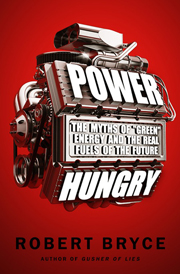You may remember Robert Bryce from his book, “Gusher of Lies,” Bryce is back with his new book, “Power Hungry.” I shouldn’t have liked this book – his last one made me angry. I should have stopped reading after the introduction – he made his point of the book very clear. But I read the entire book and believe it or not, there are a few issues with which I actually agreed with him.
 Bryce has four imperatives that he has created to measure the value of a particular form of energy. The four imperatives include power density, energy density, cost, and scale. Let me quickly tell you what forms of alternative energy don’t make the grade: biofuels, wind, solar or electric vehicles. What does make the grade? Natural gas to nuclear and Bryce lays out his N2N plan to support the growth of both of these forms of energy.
Bryce has four imperatives that he has created to measure the value of a particular form of energy. The four imperatives include power density, energy density, cost, and scale. Let me quickly tell you what forms of alternative energy don’t make the grade: biofuels, wind, solar or electric vehicles. What does make the grade? Natural gas to nuclear and Bryce lays out his N2N plan to support the growth of both of these forms of energy.
He writes, “It may be fashionable to promote wind, solar, and biofuels, but those sources fail when it comes to power density. We want energy sources that produce lots of power from small amounts of real estate. And that’s the key problem with wind, solar, and biofuels. They require huge amounts of land to generate meaningful amounts of power. And although the farm lobby loves biofuels such as corn ethanol, that fuel fails on two counts: power density and energy density. Corn ethanol production requires vast swathes of land, and the fuel that it produces is inferior to gasoline because it is corrosive, it is hydrophilic, and it contains just two-thirds of gasoline’s heat content.”
In an entire section of the book, Byrce lays out the reasons why renewable energy is not in America’s best interest. However, prior to that he does at least dismiss coal as an option for the future, and he does portray carbon sequestration as a farce.
At the end of the book, Byrce “rethinks green” and offers a few suggestions for the future. He also lays out the steps of his N2N Plan:
- 1) Promote natural gas and nuclear power through targeted use of tax incentives.
- 2) Encourage oil and gas production in the United States.
- 3) Continue Promoting energy efficiency.
- 4) Continue working on renewables and energy storage technologies such as batteries and compressed-air energy storage.
I’ll let Bryce’s N2N plan speak for itself and with that my friends, if you’ll learn one thing from this book, is that you’ll understand, in great detail, all the cards being played by the anti-renewable energy movement.

